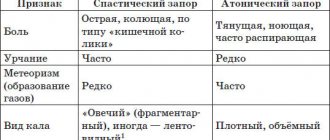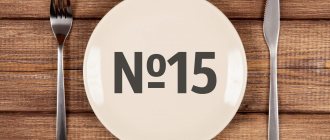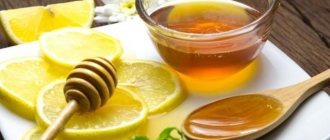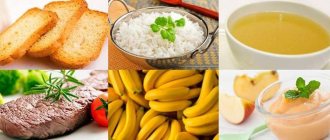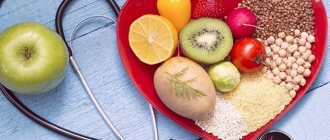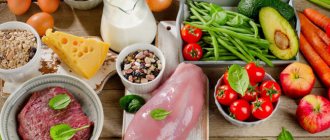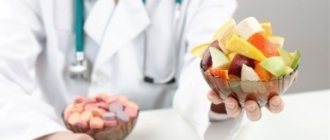Prohibited foods for atherosclerosis
Patients with atherosclerosis should avoid:
- animal fats (butter, cream, lard);
- fatty meat (pork, geese and duck);
- fatty broths;
- sausages and pates;
- offal: liver, kidneys and brains;
- high-fat dairy products, including ice cream;
- fat cheese;
- mayonnaise;
- sour cream sauces;
- fried potatoes, including chips;
- fish caviar;
- baked goods;
- high-calorie desserts;
- cocoa, chocolate.
Advantages and disadvantages
| pros | Minuses |
|
|
What foods should you limit your consumption?
In small quantities you can use:
- vegetable fats;
- eggs (1-2 per week);
- rice and semolina cereals;
- soy sauce;
- pasta;
- flour products without cream;
- seasonings and spices;
- mineral still water;
- juices without added sugar;
- weak coffee and tea;
- sweets: honey, sugar, marshmallow, marmalade, fruit syrup;
- salt (no more than 6 grams per day);
- liquid (no more than 1.5 liters including first courses).
Products that are beneficial
It is necessary to increase the content in the diet:
- lean chicken, turkey, game;
- veal, lamb and rabbit;
- sea and ocean fish;
- seafood (seaweed, squid, scallops, crabs, mussels, oysters, shrimp);
- low-fat fermented milk products;
- vegetables and fruits (at least 400 grams per day), especially useful are peas, beans, beans, lentils, cabbage, potatoes, eggplants, peaches, apricots, dried apricots, prunes, pineapples, rose hips;
- mushrooms;
- greens (lettuce, dill, parsley, spinach, cilantro);
- onions and garlic;
- nuts (walnuts, almonds);
- cereals (oatmeal, millet, buckwheat, soybean);
- bread made from coarse flour.
Vitamins will be useful. The exception is vitamin D (it is contraindicated for atherosclerosis).
Exclude
Many foods should be completely excluded from the diet, however, if it is psychologically difficult to do this, you can give yourself some slack once in a certain period of time (a week, a month, etc.) and eat something in small quantities, the main thing is not to lose your temper. The diet for vascular atherosclerosis should be strict, and only in the hands of everyone lies the key to its effectiveness. List to exclude from the diet:
- Margarine.
- Butter.
- Sugar.
- Carbonated drinks.
- Cream cakes.
- Salo.
- Fatty sausages.
- Fast food products (burgers, French fries, etc.).
Rules for proper nutrition for atherosclerosis
People suffering from atherosclerosis should eat 4-5 times a day, but little by little. You should have dinner no later than 2 hours before bedtime.
It is necessary to cook food in vegetable oil, preferably without salt, adding salt at the table. Mostly boiled and baked foods should be consumed.
It is recommended to knead dough for confectionery products only with egg whites, without using yolks.
If atherosclerosis is accompanied by excess weight, then the patient will benefit from fasting days on kefir, cottage cheese, vegetables and fruits. You should also reduce your consumption of bread, potatoes, cereals and sugar.
For patients prone to increased blood clotting, it is advisable to add seafood, especially seaweed, to their food.
Reviews and results
This diet is designed to last for a long time, as it is balanced and contains a variety of foods. Some restriction in carbohydrates and fats does not adversely affect health, but on the contrary allows you to lose weight, normalize cholesterol and feel good. All these points are noted in the reviews of patients.
- “...I improved my health and lost weight. I liked this healthy diet. True, I was also prescribed pills to lower cholesterol”;
- “... I’m happy with the results: cholesterol has decreased, sugar has normalized, and I’ve even lost weight. Beauty!";
- “...Cholesterol was not very high, so I managed only with therapeutic nutrition. I continue to eat like this”;
- “... My result is minus 5 kg, my general condition has improved significantly and my tests have become normal”;
- “... Helped me lose weight and improve my condition, but I think that the tests became normal thanks to the pills. I won’t push myself further and will eat right.”
- “... This is not even a diet, but proper nutrition. I see only benefits in low-fat dishes without frying or batter. I eat constantly, even though no one prescribed it for me. Cholesterol is normal."
The essence
Brief description of the diet. Type: therapeutic, hypolipidemic. Duration: until cholesterol levels normalize or for life if hypercholesterolemia is chronic or there is a predisposition to it. Results: keeping LDL concentration in the blood within normal limits, minimizing complications. Difficulty: medium.
For high cholesterol, a diet is prescribed, which is characterized by the following features:
- constant monitoring of daily caloric intake;
- compliance with the principles of proper nutrition;
- optimal balance of all nutrients necessary for the body (BJU);
- using the characteristics of a balanced diet: taking into account climate, concomitant diseases (hypertension, Gilbert's syndrome, obesity, diabetes), age, cholesterol level, gender differences, degree of complications.
The main feature of the diet is its therapeutic effect. It is intended primarily to normalize well-being and reduce the risk of complications. Therefore, first you need to consult with a specialist (therapist, cardiologist, phlebologist) to clarify the diagnosis, and then, with the test results and doctors’ conclusions, contact a nutritionist who will help you create the right menu. Subsequently, based on it, you can develop your own version of the diet.
About drinks
In order not to create additional stress on the blood vessels of the brain and heart, you should stop drinking coffee. Sweet soda should be completely excluded from the diet. Healthy drinks include:
- compote of fresh or frozen berries;
- fruit compote or jelly (no added sugar);
- green tea with mint;
- fresh vegetable;
- decoction of rosehip, burdock and dandelion roots;
- ginger-citrus drink.
Advice! To prepare a ginger-citrus drink, you need to cut 1 orange and 1 lemon, brew with boiling water, leave for a quarter of an hour, add grated ginger root. You can drink at any time of the day. The drink has a powerful antioxidant effect, helps lower cholesterol, strengthens the immune system, and promotes weight loss.
How to get out of a diet
If the lipid-lowering diet is a temporary phenomenon in your life, then you need to take care of its proper termination. A gentle, smooth exit from the diet is the basic rule for maintaining the achieved result. A competent exit means a gradual return to a normal diet. But in order to maintain the achieved weight, it is advisable to continue to adhere to the basic principles of the diet, for example, fractional meals. It is recommended to follow the “80 out of 100” rule. This means that 80% of the diet should coincide with the routine of the technique, and the remaining 20% will be taken up by the usual lifestyle.
What it is?
A hypolipidemic or lipid diet is intended not only for weight correction, but also for medicinal purposes.
Experts prescribe it for the prevention of coronary artery disease, myocardial infarction and diabetes mellitus, and also use it in the complex treatment of diseases of the cardiovascular system. The main goal of the diet is to reduce the concentration of cholesterol in the blood. Cholesterol is a steroid substance, partially synthesized by the body, and the rest comes from food. It is actively involved in the production of vitamins, correction of cell membrane permeability, and also stabilizes the activity of the immune system and controls biochemical processes.
The human body lacks the function of regulating cholesterol levels, so when too much of it comes from outside, it begins to accumulate. The norm for a healthy adult is 3.6-5.2 mmol/l. Exceeding these figures entails a threat to health, and subsequently the development of dangerous diseases.
The basic principle of a lipid-lowering diet is the exclusion of animal fats and easily digestible carbohydrates from the diet. As a result, excess cholesterol is eliminated. At the same time, calorie intake is automatically reduced, and weight begins to decrease.
You can't expect quick results. The effect of weight loss can be noticed after a couple of weeks, and changes in cholesterol levels in the blood can be monitored using tests.
Expert opinion
A lipid-lowering diet should be used as part of the treatment of certain diseases under the direct supervision of a physician. It plays a supporting role, but not a determining one. Without appropriate therapy, it is impossible to cure, for example, heart disease with diet alone. Such pathologies should be treated exclusively in a hospital setting under constant supervision. As for weight correction, you definitely shouldn’t expect great results from a lipid diet. It is generally impossible to maintain a low-calorie diet for a long time without medical indications. The best option for losing weight is proper nutrition, physical activity and the ability to control eating habits.
Recipes
A small selection of interesting recipes for a lipid diet:
- Carrot cheesecakes. The main ingredient is a package of low-fat cottage cheese. You will also need carrots, a couple of tablespoons of flour, semolina, 1 protein, 0.5 cups of low-fat milk, a little salt, olive oil. Carrots need to be grated on a fine grater. Then add semolina with milk and cottage cheese and put it on low heat in a saucepan. After cooling, protein, salt and flour are added and the dough is kneaded. Bake the formed cheesecakes in the oven.
- Apple semolina pudding. Chop the peeled apples. Next, cook milk semolina porridge, then add protein, salt and butter to it. After mixing all the ingredients, beat with a mixer. Place the mixture on a baking sheet or in a mold and bake in the oven for forty minutes.
- Omelet with mushrooms and vegetables. Beat several chicken eggs, adding salt and sour cream. Chop the spinach and some of the mushrooms and add them to the egg mixture. Pour the resulting mixture into the mold and bake in the oven. Once crust has formed, sprinkle the remaining mushrooms on top and bake for another ten minutes. Before serving, you can garnish with fresh herbs.
- Radish and celery salad. Cut the radishes and celery stalks into slices. Finely chop the onion. Mix all the vegetables and season with natural yogurt. Some people like to sprinkle sesame seeds on their salad.
Results
Atherosclerosis is a dangerous disease of the body’s vascular system, characterized by the deposition of “bad” cholesterol on the intima (inner layer of blood vessels). At the same time, the level of “good” cholesterol is significantly reduced.
The compaction and proliferation of cholesterol plaques leads to blockage of the lumen of the arteries, causing coronary heart disease, cerebrovascular accident with the risk of stroke, and gangrenous lesions of the lower extremities. A proper diet helps lower cholesterol levels and maintain their stability.
A diet developed on the basis of the “Table 10” diet should contain a maximum of fresh vegetables, berries and fruits, cereals and protein dishes, and healthy drinks. Therapy of atherosclerosis is a long process. It is important to strictly follow nutritional rules not only during treatment, but also for prevention (after cholesterol levels decrease).
